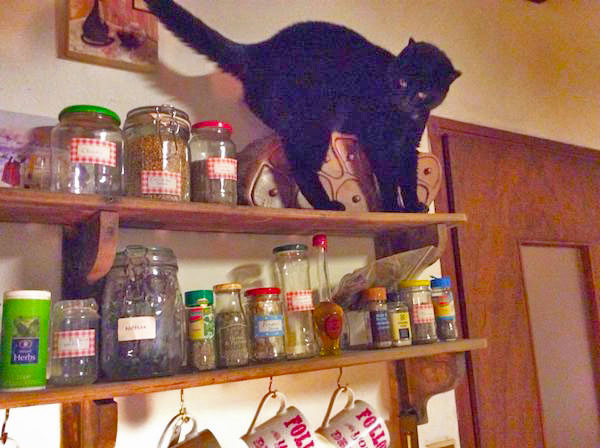
Swear by what the Sages spoke
Round the Mareotic Lake
That the Witch of Atlas knew,
~ W.B.Yeats, Under Ben Bulben
~
My Grandad was a Herb Witch. He was born to the O’Dwyer family of Sligo Town, a small harbour port on the North West coast of Ireland, where they lived for many generations.
Parents and children crossed the Irish Sea in the early 20th century to find work and settled in Lancashire, England. It is the neighbouring county to Cumbria; the birthplace of St. Patrick, who later became the Patron Saint of Ireland.
The ‘O’ was dropped from their surname, common amongst Irish settlers, and my Grandad’s name became Francis Dwyer. A great name for a Herb Witch.
County Sligo was once home to W.B. Yeats, famous for his poetry and prose—and is where he is buried. His open interest in the witches of Ireland is evident throughout his writings.
Bram Stoker‘s mother also originated from Sligo Town. His inspiration for Dracula came from the local supernatural tales his mom read to him as a child.
Irish folklore is plenteous with myths and legends of witches, their spells, and potions; from young maidens collecting herbs in meadows, barks and sap from woodlands, or the old hag, Cailleach, bent over her cauldron, stirring magic into the brew whilst uttering spells.
But not all witches are women.
Many male witches were hunted, tried and executed during the Witch Trials, including those in Salem, Massachusetts between 1692 and 1693. The British Witchcraft Act was still in place as late as 1956 when Grandad was in his thirties.
Today, we honour our white Herb Witches for their wise contribution to our knowledge of natural and herbal remedies.
As a child, I remember how Grandad Dwyer collected herbs from the meadows and hedgerows, including the comfrey plant for its medicinal properties.
Symphytum Officinale (comfrey) is nicknamed “knitbone,” due to its anti-inflammatory ingredients. The plant contains allantoin that aids in the healing of broken bones, wounds and bruises, along with the proliferation of skin cells.
Grandad Dwyer collected these tall plants from mossy peatland near his home, gathering bunches under one arm, a hand-made walking staff held under the other. His wooden staff was not unlike the one made of ash that St. Patrick had used on his mission to rid Ireland of Druids and Pagans.
Many believe that St. Patrick was in fact, a Witch Hunter.
My Grandad would return home to make swift use of the fresh leaves if required, or hang dry his collection of stems and roots for later.
I have vivid memories of soaking a twisted ankle in a washing-up bowl of warm water, stained dark green from the comfrey pulp. On his knees, my Grandad would gather the wet leaves in the water and wrap them, like a poultice, loosely around my foot, a term in Gaelic known as ceirín a chur le cneá.
It is of no coincidence that the term “poultice” in Irish slang translates as “stupid,” (meaning if you break a bone or let’s say, twist your ankle, it was a stupid thing to do. And you had to endure a wet poultice making you look like an idiot).
So there I sat, feeling stupid but cared for by my Grandad, for a couple of hours with the distinctive and highly pungent aroma of the herb, suffusing the skin and bone.
Today, I collect comfrey whenever I can and make my own remedies and poultices.
A healing session takes only two hours and you need just two ingredients: a bunch of wet or dry comfrey leaves and a large bowl.
A cloth poultice can be made by chopping fresh comfrey leaves, blending or mashing them with water, adding a little flour to bind, and then wrapping the pulp into muslin or other recycled material before applying to the body.
One of my favourite traditional methods is a cold oil infusion, particularly beneficial for skin problems such as dermatitis or eczema. Here is the recipe:
~
1. A bunch of wet comfrey leaves and/or comfrey root (finely chopped).
2. Add the ingredients to a jar or bottle that has a tight seal.
3. Cover the leaves with olive or sunflower oil then shake the jar/bottle.
4. Allow the mixture to infuse for two to four weeks in a cool, dark place.
5. Remove and strain the leaves.
6. The oil can be applied directly to unbroken skin (always test a small area first).
~
If he was alive today, Grandad Dwyer would be proud of my collection and, indeed, my inherited craft.
Being a Herb Witch is ancestral. Knowledge passes through DNA and spans many of our lifetimes.
But what about my journey as a Herb Witch across meadows, woodlands and seas?
Well, that’s another Irish tale.
~
Author: Shelley Dootson-Greenland
Image: Courtesy of author
Editor: Deb Jarrett
~








Read 1 comment and reply